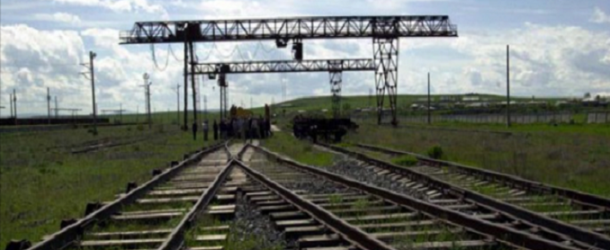International transportation issue has been a lingering problem for Armenia since the day it declared its independence. The northern transportation corridor that runs across Azerbaijan has been inaccessible after occupation of Azerbaijan’s territory. Although Armenia uses the Upper Lars customs checkpoint in Georgia, for political, geographic, environmental and other reasons it occasionally encounters significant problems there. That is to say that Upper Lars simply cannot accommodate completely Armenia’s needs.
Armenia once raised the issue of using Poti – Port Caucasus ferry boat route in the Black Sea but the subject was dropped due to the high prices. The South Ossetia and Abkhazia railroad link that could serve as Armenia’s northern transportation route has remained inoperative for obvious reasons in the last 25 years. Despite that Armenia and Russia have several times brought up the issue of reopening that railroad connection, Georgia objected because in that case Abkhazia and South Ossetia would have gained greater political and economic dividends.[i] Armenia’s efforts to gain international access via Iran have also failed.
The Upper Lars customs checkpoint has been closed since 23 June due do dangerously high water level in the Terek River. And although it briefly reopened, the facility is yet to operate at full capacity. The so-called “Georgian military road” is not used regularly due to the dangerous geography. This is why there has been a long line of passenger and cargo vehicles travelling from Armenia to Russia and vice-versa stuck at the Upper Lars. The situation has gotten to the point that the Ministry of Transportation of Armenia and the State Committee on Emergency Situations had to arrange an aircraft to recover the people stranded there.
Armenian authorities have raised these problems with the Georgian and Russian officials, yet there is a little of chance of finding a quick solution. The Armenian companies that use this route frequently criticize their government and blame it for multimillion dollar losses. According to the expert calculations, the most recent incident at the Upper Lars entailed losses of $ 1000 per truck, and it is just the shipping companies’ losses but let us not forget the consignors.
The Ministry of Economy of Armenia commissioned its Trade Office in Russia to raise the issue with the appropriate Russian government institutions in order to find an immediate resolution. Armenia’s Economy Minister Artsvik Minasyan stressed the importance of initiating talks with the Russian authorities regarding the availability of air transport for the delivery of perishable agriculture and other goods under such force majeure circumstances.[ii] Yet the positive outcome is very unlikely due to the high rates for the air cargo transportation.
The Armenian experts stress the fact that the Upper Lars checkpoint cannot operate year-round. Winter avalanches, heavy rains in fall and danger of floods during spring season are among the main impediments for full-scale operations. Every time the Upper Lars checkpoint experiences difficulties the Armenian officials turn to the question of the Abkhazia and South Ossetia railroad connection. Indeed, for the time being, the railroad connection in that direction is inconceivable. That is to say, if the Upper Lars faces interruptions due to the power of nature or technical glitches and thus creating transportation nightmare for Armenia, the Abkhazia and South Ossetia railroad has political hurdles ahead of itself. Although Georgia also conducts operations through the Upper Lars checkpoint, it uses own seaports whenever that checkpoint stalls – a luxury that Armenian companies cannot afford.
Some Armenian experts argue that Armenia’s trade relations with Russia offer no prospects and therefore, they argue in favor of forging Iran-Armenia-Georgia transportation route or establishing a link between the Persian Gulf and the Black Sea. Nevertheless, the problem is that the proposed routes lack appropriate infrastructure and creation of such infrastructure would require enormous investments.
Country’s Transportation Minister Gagik Beyleryan stated that in the meetings with his counterparts the issue of construction of a railroad link arises often. However, since any project involves tunnel construction, it increases significantly the project cost. And given that no party has yet expressed its interest in such expensive ventures, he recommended that the Armenian businessmen took into consideration the seasonal circumstances.
Armenia has fallen victim to its disastrous foreign, economic and security policy conducted in the past 25 years. Azerbaijan’s territory that it has maintained under occupation brings no dividends whatsoever. On the contrary, it has resulted in Armenia finding itself isolated from major international economic and infrastructure projects. The likes of Baku-Tbilisi-Ceyhan oil pipeline, Baku-Tbilisi-Erzurum gas pipeline and Baku-Tbilisi-Kars railroad projects all bypass Armenia. The country is deprived also of an opportunity to benefit from affordable and secure railroad link to the north of Azerbaijan.
Armenia fails to embrace the geopolitical situation in the region and is unable to capitalize on most of the opportunities on the ground. Without serious changes made to its foreign and security policy, be it with respect to the Nagorno Karabakh conflict or relations with the neighboring countries, Armenia will stand no chance of resolving its transportation grievances.
Dr. Hatem CABBARLI
[i] Тбилиси: Открытие ж/д сообщения через Абхазию на повестке дня не стоит, http://www.panarmeniannet/rus/news/195755/, 7 августа 2015.
[ii] Верхний Ларс: О чем думает правительство Армении, http://news.am/rus/news/336692.html, 12.07.16




















































